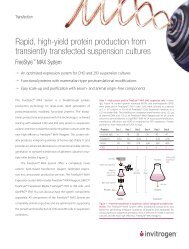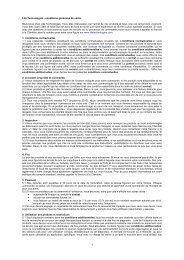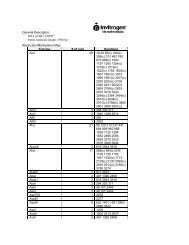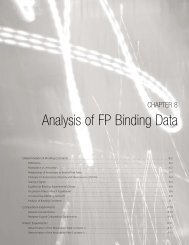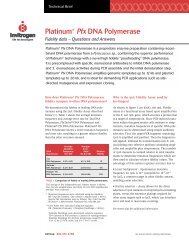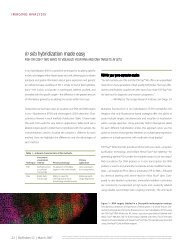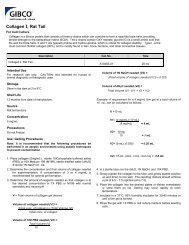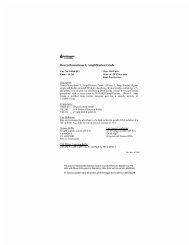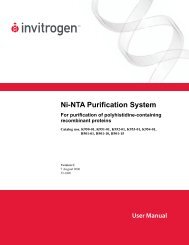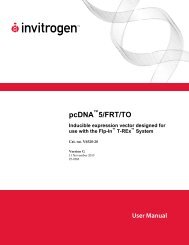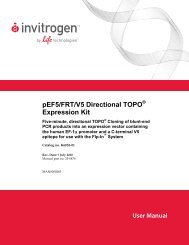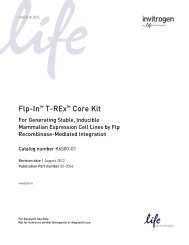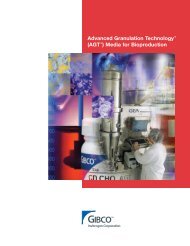pEF5/FRT/V5-DEST Gateway - Invitrogen
pEF5/FRT/V5-DEST Gateway - Invitrogen
pEF5/FRT/V5-DEST Gateway - Invitrogen
You also want an ePaper? Increase the reach of your titles
YUMPU automatically turns print PDFs into web optimized ePapers that Google loves.
<strong>pEF5</strong>/<strong>FRT</strong>/<strong>V5</strong>-<strong>DEST</strong> <strong>Gateway</strong> <br />
Vector<br />
A destination vector for cloning and<br />
expression in mammalian cells using the<br />
Flp-In System<br />
Catalog no. V6020-20<br />
Rev. Date: 14 July 2010<br />
Manual part no. 25-0477<br />
MAN0000266<br />
User Manual
Contents<br />
Important Information ........................................................................................ iv<br />
Accessory Products............................................................................................... v<br />
Methods............................................................................................... 1<br />
Overview .................................................................................................................1<br />
Using <strong>pEF5</strong>/<strong>FRT</strong>/<strong>V5</strong>-<strong>DEST</strong> .................................................................................5<br />
Generating Stable Flp-In Expression Cell Lines .............................................8<br />
Appendix...........................................................................................12<br />
Human EF-1 Promoter .......................................................................................12<br />
Map and Features of <strong>pEF5</strong>/<strong>FRT</strong>/<strong>V5</strong>-<strong>DEST</strong>.....................................................13<br />
Map of <strong>pEF5</strong>/<strong>FRT</strong>/<strong>V5</strong>/GW-CAT .....................................................................15<br />
Technical Support ................................................................................................16<br />
Purchaser Notification.........................................................................................18<br />
<strong>Gateway</strong> ® Clone Distribution Policy.................................................................21<br />
References..............................................................................................................22<br />
iii
Important Information<br />
Shipping and<br />
Storage<br />
iv<br />
<strong>pEF5</strong>/<strong>FRT</strong>/<strong>V5</strong>-<strong>DEST</strong> and <strong>pEF5</strong>/<strong>FRT</strong>/<strong>V5</strong>/GW-CAT are<br />
shipped at room temperature. Upon receipt, store at –20C.<br />
Products are guaranteed for six months from date of<br />
shipment when stored properly.<br />
Contents The <strong>pEF5</strong>/<strong>FRT</strong>/<strong>V5</strong>-<strong>DEST</strong> <strong>Gateway</strong> Vector components are<br />
listed below.<br />
Item Concentration Amount<br />
<strong>pEF5</strong>/<strong>FRT</strong>/<strong>V5</strong>-<strong>DEST</strong> Vector lyophilized in TE, pH 8.0 6 g<br />
<strong>pEF5</strong>/<strong>FRT</strong>/<strong>V5</strong>/GW-CAT<br />
Control Plasmid<br />
lyophilized in TE, pH 8.0 10 g<br />
Intended Use For research use only. Not intended for human or animal<br />
diagnostic or therapeutic uses.
Accessory Products<br />
Additional<br />
Products<br />
Additional products that may be used with <strong>pEF5</strong>/<strong>FRT</strong>/<strong>V5</strong>-<br />
<strong>DEST</strong> are available from <strong>Invitrogen</strong>. Ordering information is<br />
provided below.<br />
Product Amount Catalog no.<br />
Hygromycin 1 g R220-05<br />
Zeocin 1 g R250-01<br />
<br />
5 g R250-05<br />
<strong>Gateway</strong> LR Clonase Enzyme Mix 20 reactions 11791-019<br />
p<strong>FRT</strong>/lacZeo 20 g, lyophilized in TE V6015-20<br />
p<strong>FRT</strong>/lacZeo2 20 g, lyophilized in TE V6022-20<br />
pOG44 20 g, lyophilized in TE V6005-20<br />
One Shot 10 reactions C4040-10<br />
® TOP10<br />
Chemically Competent Cells<br />
20 reactions C4040-03<br />
One Shot 10 reactions C4040-50<br />
® TOP10<br />
Electrocompetent Cells<br />
20 reactions C4040-52<br />
CAT Antiserum* 50 L R902-25<br />
*The amount supplied is sufficient to perform 25 Western blots using 10 mL working<br />
solution per reaction.<br />
Flp-In <br />
Expression<br />
Vectors<br />
Additional Flp-In expression vectors are available from<br />
<strong>Invitrogen</strong>. For more information about each vector, refer to<br />
our Web site (www.invitrogen.com) or contact Technical<br />
Support (page 16).<br />
Product Amount Catalog no.<br />
<strong>pEF5</strong>/<strong>FRT</strong>/<strong>V5</strong> Directional TOPO ®<br />
Expression Kit<br />
1 kit K6035-01<br />
pcDNA5/<strong>FRT</strong> 20 g, lyophilized in TE V6010-20<br />
pcDNA5/<strong>FRT</strong>/<strong>V5</strong>-His TOPO ® TA<br />
Expression Kit<br />
pSecTag/<strong>FRT</strong>/<strong>V5</strong>-His TOPO ® TA<br />
Expression Kit<br />
1 kit K6020-01<br />
1 kit K6025-01<br />
continued on next page<br />
v
Accessory Products, continued<br />
Flp-In Host<br />
Cell Lines<br />
Detection of<br />
Recombinant<br />
Proteins<br />
vi<br />
For your convenience, <strong>Invitrogen</strong> has available several<br />
mammalian Flp-In host cell lines that stably express the<br />
lacZ-Zeocin fusion gene from p<strong>FRT</strong>/lacZeo or p<strong>FRT</strong>/lacZeo2.<br />
Each cell line contains a single integrated <strong>FRT</strong> site as<br />
confirmed by Southern blot analysis. The cell lines should be<br />
maintained in medium containing Zeocin . For more<br />
information, refer to our Web site (www.invitrogen.com) or<br />
contact Technical Support (page 16).<br />
Cell Line Amount Catalog no.<br />
Flp-In-293 3 x 106 cells, frozen R750-07<br />
Flp-In-CV-1 3 x 106 cells, frozen R752-07<br />
Flp-In-CHO 3 x 106 cells, frozen R758-07<br />
Flp-In-BHK 3 x 106 cells, frozen R760-07<br />
Flp-In-3T3 3 x 106 cells, frozen R761-07<br />
Flp-In-Jurkat 3 x 106 cells, frozen R762-07<br />
Expression of your recombinant fusion protein can be<br />
detected using Anti-<strong>V5</strong> antibodies available from <strong>Invitrogen</strong>.<br />
Horseradish peroxidase (HRP) or alkaline phosphatase (AP)conjugated<br />
antibodies allow one-step detection using<br />
colorimetric or chemiluminescent detection methods.<br />
Fluorescein isothiocyanate (FITC)-conjugated antibodies<br />
allow one-step detection in immunofluorescence experiments.<br />
The amount of antibody supplied is sufficient for 25 Western<br />
blots or 25 immunostaining reactions (FITC-conjugated<br />
antibody only).<br />
Product Epitope Catalog no.<br />
Anti-<strong>V5</strong> Antibody Detects 14 amino acid epitope R960-25<br />
Anti-<strong>V5</strong>-HRP Antibody<br />
derived from the P and V<br />
proteins of the paramyxovirus,<br />
R961-25<br />
Anti-<strong>V5</strong>-AP Antibody S<strong>V5</strong> (Southern et al., 1991). R962-25<br />
Anti-<strong>V5</strong>-FITC Antibody GKPIPNPLLGLDST R963-25
Overview<br />
1<br />
Methods<br />
Description <strong>pEF5</strong>/<strong>FRT</strong>/<strong>V5</strong>-<strong>DEST</strong> is a 7.5 kb vector designed to allow<br />
high-level, constitutive expression of the gene of interest in<br />
a variety of mammalian hosts using the Flp-In System.<br />
Once <strong>pEF5</strong>/<strong>FRT</strong>/<strong>V5</strong>-<strong>DEST</strong> is recombined with an<br />
appropriate entry clone, the resulting expression clone may<br />
also be used for transient expression of your gene of<br />
interest. For more information on the <strong>Gateway</strong> Technology<br />
and the Flp-In System, see the next page.<br />
Features <strong>pEF5</strong>/<strong>FRT</strong>/<strong>V5</strong>-<strong>DEST</strong> contains the following elements:<br />
Human EF-1 promoter for high-level expression across a<br />
wide range of mammalian cells (see page 12 for a diagram)<br />
Two recombination sites, attR1 and attR2, downstream of<br />
the EF-1 promoter for recombinational cloning of the<br />
gene of interest from an entry clone<br />
Chloramphenicol resistance gene located between the two<br />
attR sites for counterselection<br />
ccdB gene located between the two attR sites for negative<br />
selection<br />
<strong>V5</strong> epitope tag for detection<br />
Bovine growth hormone (BGH) polyadenylation sequence<br />
for proper termination and processing of the recombinant<br />
transcript<br />
FLP Recombination Target (<strong>FRT</strong>) site for Flp recombinasemediated<br />
integration of the vector into the Flp-In host<br />
cell line (see pages 3-4 for more information)<br />
Hygromycin resistance gene for selection of stable cell<br />
lines (see important note on page 4)<br />
The pUC origin for high copy replication and<br />
maintenance of the plasmid in E. coli<br />
The ampicillin (bla) resistance gene for selection in E. coli<br />
For a map of <strong>pEF5</strong>/<strong>FRT</strong>/<strong>V5</strong>-<strong>DEST</strong>, see page 13. For more<br />
information on the EF-1 promoter, see page 12.<br />
continued on next page
Overview, continued<br />
The <strong>Gateway</strong> <br />
Technology<br />
The Flp-In <br />
System<br />
<strong>Gateway</strong> is a universal cloning technology that takes<br />
advantage of the site-specific recombination properties of<br />
bacteriophage lambda (Landy, 1989) to provide a rapid and<br />
highly efficient way to move your gene of interest into<br />
multiple vector systems. To express your gene of interest<br />
using <strong>Gateway</strong> Technology, simply:<br />
1. Clone your gene of interest into a <strong>Gateway</strong> entry vector<br />
to create an entry clone.<br />
2. Generate an expression clone by performing an LR<br />
recombination reaction between the entry clone and a<br />
<strong>Gateway</strong> destination vector (e.g. <strong>pEF5</strong>/<strong>FRT</strong>/<strong>V5</strong>-<strong>DEST</strong>).<br />
3. Transfect your expression clone into the cell line of choice<br />
for transient expression of your gene of interest. If you<br />
wish to constitutively express your gene of interest using<br />
the Flp-In System, see below.<br />
For more information on the <strong>Gateway</strong> Technology, refer to<br />
the <strong>Gateway</strong> Technology Manual. This manual is available<br />
for downloading from our Web site (www.invitrogen.com)<br />
or by contacting Technical Support (page 16).<br />
The Flp-In System allows integration and expression of<br />
your gene of interest in mammalian cells at a specific<br />
genomic location. To use the Flp-In System:<br />
1. Introduce a Flp Recombination Target (<strong>FRT</strong>) site into the<br />
genome of the mammalian cell line of choice.<br />
2. Cotransfect an expression vector containing your gene of<br />
interest (e.g. <strong>pEF5</strong>/<strong>FRT</strong>/<strong>V5</strong>-<strong>DEST</strong> expression clone) and<br />
a vector expressing Flp recombinase (pOG44) into the<br />
Flp-In host cell line. The Flp recombinase facilitates<br />
integration of the vector containing your gene of interest<br />
into the genome via Flp recombinase-mediated DNA<br />
recombination at the <strong>FRT</strong> site (O'Gorman et al., 1991).<br />
For more information about the Flp-In System, the pOG44<br />
plasmid, and generation of the Flp-In host cell line, refer to<br />
the Flp-In System manual. This manual is available for<br />
downloading from our Web site (www.invitrogen.com) or<br />
by contacting Technical Support (page 16).<br />
continued on next page<br />
2
Overview, continued<br />
Flp<br />
Recombinase-<br />
Mediated DNA<br />
Recombination<br />
3<br />
In the Flp-In System, integration of your <strong>pEF5</strong>/<strong>FRT</strong>/<strong>V5</strong>-<br />
<strong>DEST</strong> expression construct into the genome occurs via Flp<br />
recombinase-mediated intermolecular DNA recombination.<br />
The hallmarks of Flp-mediated recombination are listed<br />
below.<br />
Recombination occurs between specific <strong>FRT</strong> sites (see<br />
below) on the interacting DNA molecules<br />
Recombination is conservative and requires no DNA<br />
synthesis; the <strong>FRT</strong> sites are preserved following<br />
recombination and there is minimal opportunity for<br />
introduction of mutations at the recombination site<br />
Strand exchange requires only the small 34 bp minimal<br />
<strong>FRT</strong> site (see below)<br />
For more information about the Flp recombinase and<br />
conservative site-specific recombination, refer to published<br />
reviews (Craig, 1988; Sauer, 1994).<br />
<strong>FRT</strong> Site The <strong>FRT</strong> site, originally isolated from Saccharomyces<br />
cerevisiae, serves as a binding site for Flp recombinase and<br />
has been well-characterized (Gronostajski and Sadowski,<br />
1985; Jayaram, 1985; Sauer, 1994; Senecoff et al., 1985). The<br />
minimal <strong>FRT</strong> site consists of a 34 bp sequence containing<br />
two 13 bp imperfect inverted repeats separated by an 8 bp<br />
spacer that includes an Xba I restriction site (see figure<br />
below). An additional 13 bp repeat is found in most <strong>FRT</strong><br />
sites, but is not required for cleavage (Andrews et al., 1985).<br />
While Flp recombinase binds to all three of the 13 bp<br />
repeats, strand cleavage actually occurs at the boundaries of<br />
the 8 bp spacer region (see figure below) (Andrews et al.,<br />
1985; Senecoff et al., 1985).<br />
Minimal <strong>FRT</strong> site<br />
GAAGTTCCTATTCCGAAGTTCCTATTCTCTAGAAAGTATAGGAACTTC<br />
Xba I<br />
CS = cleavage site<br />
CS<br />
CS<br />
continued on next page
Overview, continued<br />
<strong>FRT</strong> Site in<br />
<strong>pEF5</strong>/<strong>FRT</strong>/<strong>V5</strong>-<br />
<strong>DEST</strong><br />
Important<br />
The <strong>pEF5</strong>/<strong>FRT</strong>/<strong>V5</strong>-<strong>DEST</strong> vector contains a single <strong>FRT</strong> site<br />
immediately upstream of the hygromycin resistance gene<br />
for Flp recombinase-mediated integration and selection of<br />
the <strong>pEF5</strong>/<strong>FRT</strong>/<strong>V5</strong>-<strong>DEST</strong> construct following cotransfection<br />
of the vector (with pOG44) into a Flp-In mammalian host<br />
cell line. The <strong>FRT</strong> site serves as both the recognition and<br />
cleavage site for the Flp recombinase and allows<br />
recombination to occur immediately adjacent to the<br />
hygromycin resistance gene. The Flp recombinase is<br />
expressed from the pOG44 plasmid. For more information<br />
about pOG44, refer to the pOG44 manual or the Flp-In <br />
System manual.<br />
The hygromycin resistance gene in <strong>pEF5</strong>/<strong>FRT</strong>/<strong>V5</strong>-<strong>DEST</strong><br />
lacks a promoter and an ATG initiation codon; therefore,<br />
transfection of the <strong>pEF5</strong>/<strong>FRT</strong>/<strong>V5</strong>-<strong>DEST</strong> plasmid alone into<br />
mammalian host cells will not confer hygromycin<br />
resistance to the cells. The SV40 promoter and ATG<br />
initiation codon required for expression of the hygromycin<br />
resistance gene are integrated into the genome (in the Flp-<br />
In host cell line) and are only brought into the correct<br />
proximity and frame with the hygromycin resistance gene<br />
through Flp recombinase-mediated integration of<br />
<strong>pEF5</strong>/<strong>FRT</strong>/<strong>V5</strong>-<strong>DEST</strong> at the <strong>FRT</strong> site. For more information<br />
about the generation of the Flp-In host cell line and for<br />
details on the Flp-In System, refer to the Flp-In System<br />
manual.<br />
You may transfect the expression clone (the resulting vector<br />
from the <strong>Gateway</strong> LR recombination reaction between an<br />
entry clone and <strong>pEF5</strong>/<strong>FRT</strong>/<strong>V5</strong>-<strong>DEST</strong>) into the mammalian<br />
cell line of choice for transient expression of your gene of<br />
interest.<br />
4
Using <strong>pEF5</strong>/<strong>FRT</strong>/<strong>V5</strong>-<strong>DEST</strong><br />
5<br />
Important<br />
Propagating<br />
<strong>pEF5</strong>/<strong>FRT</strong>/<strong>V5</strong>-<br />
<strong>DEST</strong><br />
The <strong>pEF5</strong>/<strong>FRT</strong>/<strong>V5</strong>-<strong>DEST</strong> vector is supplied as a supercoiled<br />
plasmid. Although <strong>Invitrogen</strong> has previously recommended<br />
using a linearized destination vector for more efficient<br />
recombination, further testing has found that linearization<br />
of this vector is NOT required to obtain optimal results for<br />
any downstream application.<br />
If you wish to propagate and maintain <strong>pEF5</strong>/<strong>FRT</strong>/<strong>V5</strong>-<strong>DEST</strong>,<br />
we recommend using Library Efficiency ® DB3.1 Competent<br />
Cells (Catalog no. 11782-018) from <strong>Invitrogen</strong> for<br />
transformation. The DB3.1 E. coli strain is resistant to CcdB<br />
effects and can support the propagation of plasmids<br />
containing the ccdB gene.<br />
Note: DO NOT use general E. coli cloning strains including<br />
TOP10 or DH5 for propagation and maintenance as these<br />
strains are sensitive to CcdB effects.<br />
Entry Clone To recombine your gene of interest into <strong>pEF5</strong>/<strong>FRT</strong>/<strong>V5</strong>-<strong>DEST</strong>,<br />
you should have an entry clone containing your gene of<br />
interest. For your convenience, <strong>Invitrogen</strong> offers the pENTR<br />
Directional TOPO ® Cloning Kit (Catalog no. K2400-20) for<br />
5 minute cloning of your gene of interest into an entry vector.<br />
For more information on entry vectors available from<br />
<strong>Invitrogen</strong>, refer to our Web site (www.invitrogen.com) or<br />
contact Technical Support (page 16).<br />
For detailed information on constructing an entry clone, refer<br />
to the specific entry vector manual. For detailed information<br />
on performing the LR recombination reaction, refer to the<br />
<strong>Gateway</strong> Technology Manual.<br />
continued on next page
Using <strong>pEF5</strong>/<strong>FRT</strong>/<strong>V5</strong>-<strong>DEST</strong>, continued<br />
Points to<br />
Consider<br />
Before<br />
Recombining<br />
Resuspending<br />
<strong>pEF5</strong>/<strong>FRT</strong>/<strong>V5</strong>-<br />
<strong>DEST</strong><br />
Recombining<br />
Your Gene of<br />
Interest<br />
Your insert should contain a Kozak translation initiation<br />
sequence with an ATG initiation codon for proper initiation<br />
of translation (Kozak, 1987; Kozak, 1991; Kozak, 1990). An<br />
example of a Kozak consensus sequence is provided below.<br />
Other sequences are possible, but the G or A at position –3<br />
and the G at position +4 are the most critical for function<br />
(shown in bold). The ATG initiation codon is shown<br />
underlined.<br />
(G/A)NNATGG<br />
If you wish to include the <strong>V5</strong> epitope tag, your gene in the<br />
entry clone should not contain a stop codon. In addition,<br />
the gene should be designed to be in frame with the <strong>V5</strong><br />
epitope after recombination. Refer to the Recombination<br />
Region on the next page.<br />
If you DO NOT wish to include the <strong>V5</strong> epitope tag, be sure<br />
that your gene contains a stop codon in the entry clone.<br />
Before you perform the LR Clonase reaction, resuspend<br />
<strong>pEF5</strong>/<strong>FRT</strong>/<strong>V5</strong>-<strong>DEST</strong> to 50-150 ng/L in sterile water.<br />
Each entry clone contains attL sites flanking the gene of<br />
interest. Genes in an entry clone are transferred to the<br />
destination vector backbone by mixing the DNAs with the<br />
<strong>Gateway</strong> LR Clonase enzyme mix (see page v for<br />
ordering information). The resulting recombination reaction<br />
is then transformed into E. coli and the expression clone<br />
selected. Recombination between the attR sites on the<br />
destination vector and the attL sites on the entry clone<br />
replaces the ccdB gene and the chloramphenicol (CmR ) gene<br />
with the gene of interest and results in the formation of attB<br />
sites in the expression clone.<br />
Follow the instructions in the <strong>Gateway</strong> Technology<br />
Manual to set up the LR Clonase reaction, transform a recA<br />
endA E. coli strain (e.g. TOP10 or DH5), and select for the<br />
expression clone.<br />
continued on next page<br />
6
Using <strong>pEF5</strong>/<strong>FRT</strong>/<strong>V5</strong>-<strong>DEST</strong>, continued<br />
Confirming<br />
the<br />
Expression<br />
Clone<br />
Recombination<br />
Region<br />
7<br />
The ccdB gene mutates at a very low frequency, resulting in<br />
a very low number of false positives. True expression clones<br />
will be ampicillin-resistant and chloramphenicol-sensitive.<br />
Transformants containing a plasmid with a mutated ccdB<br />
gene will be both ampicillin- and chloramphenicol-resistant.<br />
To check your putative expression clone, test for growth on<br />
LB plates containing 30 g/mL chloramphenicol. A true<br />
expression clone will not grow in the presence of<br />
chloramphenicol.<br />
The recombination region of the expression clone resulting<br />
from <strong>pEF5</strong>/<strong>FRT</strong>/<strong>V5</strong>-<strong>DEST</strong> entry clone is shown below.<br />
Features of the Recombination Region:<br />
Shaded regions correspond to DNA sequences<br />
transferred from the entry clone into <strong>pEF5</strong>/<strong>FRT</strong>/<strong>V5</strong>-<br />
<strong>DEST</strong> by recombination. Non-shaded regions are<br />
derived from the <strong>pEF5</strong>/<strong>FRT</strong>/<strong>V5</strong>-<strong>DEST</strong> vector.<br />
The underlined nucleotides flanking the shaded region<br />
correspond to bases 1652 and 3335, respectively, of the<br />
<strong>pEF5</strong>/<strong>FRT</strong>/<strong>V5</strong>-<strong>DEST</strong> vector sequence.<br />
3´ end of hEF-1a Intron 1<br />
1519 TCAGGTGTCG TGAGGAATTA GCTTGGTACT AATACGACTC ACTATAGGGA GACCCAAGCT<br />
AGTCCACAGC ACTCCTTAAT CGAACCATGA TTATGCTGAG TGATATCCCT CTGGGTTCGA<br />
5´ end of hEF-1a Exon 2<br />
1579 GGCTAGGTAA GCTTGGTACC GAGCTCGGAT CCACTAGTCC AGTGTGGTGG AATTCTGCAG<br />
CCGATCCATT CGAACCATGG CTCGAGCCTA A GGTGATCAGG TCACACCACC TTAAGACGTC<br />
A<br />
1652<br />
3335<br />
Pro Ala Phe Leu<br />
1639 ATATCAACAA GTTTGTACAA AAAAGCAGG CTN _______ ___ NAC CCA GCT TTC TTG<br />
TATAGTTGTT CAAACATGTT TTTTCGTCC GAN _______ GENE___<br />
NTG GGT CGA AAG AAC<br />
attB1 attB2<br />
3339<br />
Tyr Lys Val Val Asp Ile Gln His Ser Gly Gly Arg Ser Ser Leu Glu Gly<br />
TAC AAA GTG GTT GAT ATC CAG CAC AGT GGC GGC CGC TCG AGT CTA GAG GGC<br />
ATG TTT CAC CAA CTA TAG GTC GTG TCA CCG CCG GCG AGC TCA GAT CTC CCG<br />
3390<br />
T7 promoter<br />
<strong>V5</strong> epitope<br />
Pro Arg Phe Glu Gly Lys Pro Ile Pro Asn Pro Leu Leu Gly Leu Asp Ser<br />
CCG CGG TTC GAA GGT AAG CCT ATC CCT AAC CCT CTC CTC GGT CTC GAT TCT<br />
GGC GCC AAG CTT CCA TTC GGA TAG GGA TTG GGA GAG GAG CCA GAG CTA AGA<br />
Thr Arg Thr Gly ***<br />
3441 ACG CGT ACC GGT TAG TAATGAGTTT AAACCCGCTG ATCAGCCTCG ACTGTGCCTT CTA<br />
TGC GCA TGG CCA ATC ATTACTCAAA TTTGGGCGAC TAGTCGGAGC TGACACGGAA GAT
Generating Stable Flp-In Expression Cell<br />
Lines<br />
Introduction This section provides general information for cotransfecting<br />
your expression clone and pOG44 plasmids into your<br />
mammalian Flp-In host cell line to generate your stable<br />
Flp-In expression cell line. We recommend that you<br />
include the <strong>pEF5</strong>/<strong>FRT</strong>/<strong>V5</strong>/GW-CAT positive control<br />
vector and a mock transfection (negative control) to<br />
evaluate your results. Specific guidelines and protocols as<br />
well as detailed information about pOG44 and generation<br />
of the Flp-In host cell line can be found in the Flp-In System manual.<br />
Note: If you wish to assay for transient expression of your<br />
gene of interest, you may transfect the expression clone<br />
directly into the mammalian cell line of choice.<br />
RECOMMENDATION<br />
Plasmid<br />
Preparation<br />
Flp-In host cell lines which stably express the lacZ-Zeocin <br />
fusion gene from p<strong>FRT</strong>/lacZeo or p<strong>FRT</strong>/lacZeo2 and which<br />
contain a single integrated <strong>FRT</strong> site are available from<br />
<strong>Invitrogen</strong> (see page Error! Bookmark not defined. for<br />
ordering information). For more information on these cell<br />
lines, refer to our Web site (www.invitrogen.com) or contact<br />
Technical Support (page 16).<br />
Once you have generated your expression clone, you must<br />
isolate plasmid DNA for transfection. Plasmid DNA for<br />
transfection into eukaryotic cells must be very clean and<br />
free from phenol and sodium chloride. Contaminants will<br />
kill the cells, and salt will interfere with lipid complexing,<br />
decreasing transfection efficiency. We recommend isolating<br />
plasmid DNA using the S.N.A.P. MiniPrep Kit (10-15 g<br />
DNA, Catalog no. K1900-01), the S.N.A.P. MidiPrep Kit<br />
(10–200 g DNA, Catalog no. K1910-01), or CsCl gradient<br />
centrifugation.<br />
continued on next page<br />
8
Generating Stable Flp-In Expression Cell<br />
Lines, continued<br />
Positive<br />
Control<br />
Determination<br />
of Hygromycin<br />
Sensitivity<br />
9<br />
<strong>pEF5</strong>/<strong>FRT</strong>/<strong>V5</strong>/GW-CAT is provided as a positive control<br />
vector for mammalian cell transfection and expression (see<br />
page 15 for a map) and may be used to assay for recombinant<br />
protein expression levels in your Flp-In host cell line.<br />
Cotransfection of the positive control vector and pOG44 into<br />
your Flp-In host cell line allows you to generate a stable cell<br />
line expressing chloramphenicol acetyl transferase (CAT) at<br />
the same genomic locus as your gene of interest. If you have<br />
several different Flp-In host cell lines, you may use the<br />
<strong>pEF5</strong>/<strong>FRT</strong>/<strong>V5</strong>/GW-CAT control vector to compare protein<br />
expression levels between the various cell lines.<br />
To propagate and maintain the plasmid:<br />
1. Resuspend the vector in 10 L sterile water to prepare a<br />
1 g/L stock solution. Use the stock solution to<br />
transform a recA, endA E. coli strain like TOP10, DH5,<br />
JM109, or equivalent.<br />
2. Select transformants on LB agar plates containing<br />
50-100 g/mL ampicillin.<br />
3. Prepare a glycerol stock of a transformant containing<br />
plasmid for long-term storage.<br />
The <strong>pEF5</strong>/<strong>FRT</strong>/<strong>V5</strong>-<strong>DEST</strong> vector contains the hygromycin<br />
resistance gene (Gritz and Davies, 1983) for selection of<br />
transfectants with the antibiotic, hygromycin B (Palmer et al.,<br />
1987). Before generating a stable cell line expressing your<br />
protein of interest (Flp-In expression cell line), we<br />
recommend that you generate a kill curve to determine the<br />
minimum concentration of hygromycin required to kill your<br />
untransfected Flp-In host cell line. Generally, concentrations<br />
between 10 and 400 g/mL hygromycin are required for<br />
selection of most mammalian cell lines. For instructions to<br />
handle and store hygromycin B and for general guidelines on<br />
performing a kill curve, refer to the Flp-In System manual.<br />
continued on next page
Generating Stable Flp-In Expression Cell<br />
Lines, continued<br />
Important<br />
Methods of<br />
Transfection<br />
REMINDER: Remember that the hygromycin resistance gene<br />
in <strong>pEF5</strong>/<strong>FRT</strong>/<strong>V5</strong>-<strong>DEST</strong> lacks a promoter and an ATG<br />
initiation codon; therefore, transfection of the <strong>pEF5</strong>/<strong>FRT</strong>/<strong>V5</strong>-<br />
<strong>DEST</strong> plasmid alone into mammalian host cells will not<br />
confer hygromycin resistance to the cells. The SV40 promoter<br />
and ATG initiation codon required for expression of the<br />
hygromycin resistance gene are integrated into the genome<br />
(in the Flp-In host cell line) and can only be brought into the<br />
correct proximity and frame with the hygromycin resistance<br />
gene through Flp recombinase-mediated integration of<br />
<strong>pEF5</strong>/<strong>FRT</strong>/<strong>V5</strong>-<strong>DEST</strong> at the <strong>FRT</strong> site.<br />
For established cell lines (e.g. HeLa, CHO), consult original<br />
references or the supplier of your cell line for the optimal<br />
method of transfection. We recommend that you follow<br />
exactly the protocol for your cell line. Pay particular<br />
attention to medium requirements, when to pass the cells,<br />
and at what dilution to split the cells. Further information is<br />
provided in Current Protocols in Molecular Biology (Ausubel<br />
et al., 1994).<br />
Methods for transfection include calcium phosphate (Chen<br />
and Okayama, 1987; Wigler et al., 1977), lipid-mediated<br />
(Felgner et al., 1989; Felgner and Ringold, 1989) and<br />
electroporation (Chu et al., 1987; Shigekawa and Dower,<br />
1988). If you wish to use a lipid-based reagent for<br />
transfection of adherent or suspension cells, we<br />
recommend using Lipofectamine 2000 Reagent available<br />
from <strong>Invitrogen</strong> (Catalog no. 11668-027). For more<br />
information on transfection reagents available from<br />
<strong>Invitrogen</strong>, refer to our Web site (www.invitrogen.com) or<br />
contact Technical Support (page 16).<br />
continued on next page<br />
10
Generating Stable Flp-In Expression Cell<br />
Lines, continued<br />
Detection of<br />
Recombinant<br />
Fusion<br />
Proteins<br />
Assay for CAT<br />
Protein<br />
11<br />
If you have recombined the gene of interest in frame with the<br />
<strong>V5</strong> epitope, you may detect expression of your recombinant<br />
fusion protein by Western blot analysis using Anti-<strong>V5</strong><br />
antibodies available from <strong>Invitrogen</strong> (see page Error!<br />
Bookmark not defined. for ordering information). In<br />
addition, the Positope Control Protein (Catalog no. R900-50)<br />
is available from <strong>Invitrogen</strong> for use as a positive control for<br />
detection of fusion proteins containing a <strong>V5</strong> epitope tag. The<br />
ready-to-use WesternBreeze Chromogenic and<br />
WesternBreeze Chemiluminescent Kits are available from<br />
<strong>Invitrogen</strong> to facilitate detection of antibodies by colorimetric<br />
or chemiluminescent methods. For more information, refer to<br />
our Web site (www.invitrogen.com) or contact Technical<br />
Support (page 16).<br />
If you use <strong>pEF5</strong>/<strong>FRT</strong>/<strong>V5</strong>/GW-CAT as a positive control<br />
vector, you may assay for CAT expression using your method<br />
of choice. Note that CAT is fused to the C-terminal <strong>V5</strong> epitope<br />
tag, so you can use Western blot analysis and an Anti-<strong>V5</strong><br />
antibody to detect expression of CAT. CAT Antiserum is also<br />
available separately from <strong>Invitrogen</strong> (see page v for ordering<br />
information). Other commercial kits are available for assaying<br />
CAT expression. The molecular weight of the CAT fusion<br />
protein is approximately 30 kDa.<br />
The C-terminal peptide tag containing the <strong>V5</strong> epitope will<br />
add approximately 5 kDa to the size of your protein.
Appendix<br />
Human EF-1 Promoter<br />
Description The diagram below shows the features of the human EF-1<br />
promoter (Mizushima and Nagata, 1990) used in the<br />
<strong>pEF5</strong>/<strong>FRT</strong>/<strong>V5</strong>-<strong>DEST</strong> vector. Features are marked as<br />
described in Uetsuki et al., 1989.<br />
339<br />
399<br />
459<br />
519<br />
579<br />
639<br />
699<br />
759<br />
819<br />
5´ end of human EF-1 a promoter<br />
GGAGTGCCTC GTGAGGCTCC GGTGCCCGTC AGTGGGCAGA GCGCACATCG CCCACAGTCC<br />
CCGAGAAGTT GGGGGGAGGG GTCGGCAATT GAACCGGTGC CTAGAGAAGG TGGCGCGGGG<br />
TAAACTGGGA AAGTGATGTC GTGTACTGGC TCCGCCTTTT TCCCGAGGGT GGGGGAGAAC<br />
TATA box<br />
Start of Transcription<br />
CGTATATAAG TGCAGTAGTC GCCGTGAACG TTCTTTTTCG CAACGGGTTT GCCGCCAGAA<br />
Exon I<br />
5´ end of Intron 1<br />
CACAGGTAAG TGCCGTGTGT GGTTCCCGCG GGCCTGGCCT CTTTACGGGT TATGGCCCTT<br />
GCGTGCCTTG AATTACTTCC ACCTGGCTGC AGTACGTGAT TCTTGATCCC GAGCTTCGGG<br />
TTGGAAGTGG GTGGGAGAGT TCGAGGCCTT GCGCTTAAGG AGCCCCTTCG CCTCGTGCTT<br />
GAGTTGAGGC CTGGCCTGGG CGCTGGGGCC GCCGCGTGCG AATCTGGTGG CACCTTCGCG<br />
CCTGTCTCGC TGCTTTCGAT AAGTCTCTAG CCATTTAAAA TTTTTGATGA CCTGCTGCGA<br />
879 CGCTTTTTTT CTGGCAAGAT AGTCTTGTAA ATGCGGGCCA AGATCTGCAC ACTGGTATTT<br />
Sp 1<br />
939 CGGTTTTTGG GGCCGCGGGC GGCGACGGGG CCCGTGCGTC CCAGCGCACA TGTTCGGCGA<br />
Sp 1<br />
999 GGCGGGGCCT GCGAGCGCGG CCACCGAGAA TCGGACGGGG GTAGTCTCAA GCTGGCCGGC<br />
Sp 1 Sp 1<br />
1059 CTGCTCTGGT GCCTGGCCTC GCGCCGCCGT GTATCGCCCC GCCCTGGGCG GCAAGGCTGG<br />
1119<br />
1179<br />
1239<br />
1299<br />
1359<br />
1419<br />
1479<br />
CCCGGTCGGC ACCAGTTGCG TGAGCGGAAA GATGGCCGCT TCCCGGCCCT GCTGCAGGGA<br />
Sp 1<br />
GCTCAAAATG GAGGACGCGG CGCTCGGGAG AGCGGGCGGG TGAGTCACCC ACACAAAGGA<br />
Ap 1<br />
AAAGGGCCTT TCCGTCCTCA GCCGTCGCTT CATGTGACTC CACGGAGTAC CGGGCGCCGT<br />
CCAGGCACCT CGATTAGTTC TCGAGCTTTT GGAGTACGTC GTCTTTAGGT TGGGGGGAGG<br />
GGTTTTATGC GATGGAGTTT CCCCACACTG AGTGGGTGGA GACTGAAGTT AGGCCAGCTT<br />
GGCACTTGAT GTAATTCTCC TTGGAATTTG CCCTTTTTGA GTTTGGATCT TGGTTCATTC<br />
3´ end of Intron 1<br />
TCAAGCCTCA GACAGTGGTT CAAAGTTTTT TTCTTCCATT TCAGGTGTCG TGA...<br />
5´ end of Exon 2<br />
continued on next page<br />
12
Map and Features of <strong>pEF5</strong>/<strong>FRT</strong>/<strong>V5</strong>-<strong>DEST</strong><br />
Map of<br />
<strong>pEF5</strong>/<strong>FRT</strong>/<strong>V5</strong>-<br />
<strong>DEST</strong><br />
Comments for <strong>pEF5</strong>/<strong>FRT</strong>/<strong>V5</strong>-<strong>DEST</strong><br />
7528 nucleotides<br />
13<br />
The map below shows the elements of <strong>pEF5</strong>/<strong>FRT</strong>/<strong>V5</strong>-<strong>DEST</strong>.<br />
DNA from the entry clone replaces the region between bases<br />
1652 and 3335. The complete sequence of <strong>pEF5</strong>/<strong>FRT</strong>/<strong>V5</strong>-<br />
<strong>DEST</strong> is available from our Web site (www.invitrogen.com)<br />
or by contacting Technical Support (page 16).<br />
T7 Cm ccdB attR2<br />
stop<br />
R<br />
attR1 <strong>V5</strong> epitope<br />
Ampicillin<br />
P EF-1a<br />
<strong>pEF5</strong>/<strong>FRT</strong>/<strong>V5</strong>-<br />
<strong>DEST</strong><br />
7528 bp<br />
pUC ori<br />
BGH pA<br />
EF-1a promoter: bases 348-1531<br />
T7 promoter: bases 1548-1567<br />
attR1 recombination site: bases 1645-1769<br />
Chloramphenicol resistance gene: bases 1878-2537<br />
ccdB gene: bases 2879-3184<br />
attR2 recombination site: bases 3225-3349<br />
<strong>V5</strong> epitope: bases 3402-3443<br />
BGH polyadenylation signal: bases 3487-3711<br />
<strong>FRT</strong> site: bases 3994-4041<br />
Hygromycin resistance gene (no ATG): bases 4049-5069<br />
SV40 early polyadenylation signal: bases 5201-5331<br />
pUC origin: bases 5714-6387<br />
bla promoter: bases 7393-7491 (complementary strand)<br />
Ampicillin (bla) resistance gene: bases 6532-7392 (complementary strand)<br />
SV40 pA<br />
<strong>FRT</strong><br />
Hygromycin<br />
continued on next page
Map and Features of <strong>pEF5</strong>/<strong>FRT</strong>/<strong>V5</strong>-<strong>DEST</strong>,<br />
continued<br />
Features of<br />
<strong>pEF5</strong>/<strong>FRT</strong>/<strong>V5</strong>-<br />
<strong>DEST</strong><br />
<strong>pEF5</strong>/<strong>FRT</strong>/<strong>V5</strong>-<strong>DEST</strong> (7528 bp) contains the following<br />
elements. All features have been functionally tested.<br />
Feature Benefit<br />
Human elongation factor 1 (hEF-<br />
1) promoter<br />
Allows overexpression of your recombinant<br />
protein in a broad range of mammalian cell types<br />
(Goldman et al., 1996; Mizushima and Nagata,<br />
1990)<br />
T7 promoter Allows in vitro transcription in the sense<br />
orientation<br />
attR1 and attR2 sites Allows recombinational cloning of the gene of<br />
interest from an entry clone<br />
Chloramphenicol resistance gene Allows counterselection of expression clones<br />
ccdB gene Allows negative selection of expression clones<br />
<strong>V5</strong> epitope<br />
Bovine growth hormone (BGH)<br />
polyadenylation signal<br />
Flp Recombination Target<br />
(<strong>FRT</strong>) site<br />
Hygromycin resistance gene<br />
(no ATG)<br />
Allows detection of your recombinant protein with<br />
Anti-<strong>V5</strong> antibodies (Southern et al., 1991)<br />
Allows efficient transcription termination and<br />
polyadenylation of mRNA (Goodwin and<br />
Rottman, 1992)<br />
Encodes a 34 bp (+14 bp of non-essential) sequence<br />
that serves as the binding and cleavage site for Flp<br />
recombinase (Gronostajski and Sadowski, 1985;<br />
Jayaram, 1985; Senecoff et al., 1985)<br />
Allows selection of stable transfectants in<br />
mammalian cells (Gritz and Davies, 1983) when<br />
brought in frame with a promoter and an ATG<br />
initiation codon through Flp recombinasemediated<br />
recombination<br />
SV40 early polyadenylation signal Allows efficient transcription termination and<br />
polyadenylation of mRNA<br />
pUC origin Allows high-copy number replication and growth<br />
in E. coli<br />
bla promoter Allows expression of the ampicillin (bla) resistance<br />
gene<br />
Ampicillin (bla) resistance gene Permits selection of transformants in E. coli<br />
14
Map of <strong>pEF5</strong>/<strong>FRT</strong>/<strong>V5</strong>/GW-CAT<br />
Description <strong>pEF5</strong>/<strong>FRT</strong>/<strong>V5</strong>/GW-CAT is a 6560 bp control vector<br />
expressing chloramphenicol acetyltransferase (CAT).<br />
<strong>pEF5</strong>/<strong>FRT</strong>/<strong>V5</strong>/GW-CAT was constructed using the<br />
<strong>Gateway</strong> LR recombination reaction between an entry clone<br />
containing the CAT gene and <strong>pEF5</strong>/<strong>FRT</strong>/<strong>V5</strong>-<strong>DEST</strong>. CAT is<br />
expressed as a fusion to the <strong>V5</strong> epitope tag. The molecular<br />
weight of the fusion protein is approximately 30 kDa.<br />
Map of<br />
<strong>pEF5</strong>/<strong>FRT</strong>/<strong>V5</strong>/G<br />
W-CAT<br />
Comments for <strong>pEF5</strong>/<strong>FRT</strong>/<strong>V5</strong>/GW-CAT<br />
6560 nucleotides<br />
15<br />
The map below shows the elements of <strong>pEF5</strong>/<strong>FRT</strong>/<strong>V5</strong>/GW-<br />
CAT. The complete sequence of <strong>pEF5</strong>/<strong>FRT</strong>/<strong>V5</strong>/GW-CAT is<br />
available from our Web site (www.invitrogen.com) or by<br />
contacting Technical Support (page 16).<br />
T7 attB1 CAT attB2 <strong>V5</strong> epitope<br />
stop<br />
<strong>pEF5</strong>/<strong>FRT</strong>/<strong>V5</strong>/<br />
GW-CAT<br />
6560 bp<br />
EF-1a promoter: bases 348-1531<br />
T7 promoter: bases 1548-1567<br />
attB1 recombination site: bases 1653-1669<br />
CAT ORF: bases 1699-2355<br />
attB2 recombination site: bases 2356-2381<br />
<strong>V5</strong> epitope: bases 2434-2475<br />
BGH polyadenylation signal: bases 2519-2743<br />
<strong>FRT</strong> site: bases 3026-3073<br />
Hygromycin resistance gene (no ATG): bases 3081-4101<br />
SV40 early polyadenylation signal: bases 4233-4363<br />
pUC origin: bases 4746-5419<br />
bla promoter: bases 6425-6523 (complementary strand)<br />
Ampicillin (bla) resistance gene: bases 5564-6424 (complementary strand)<br />
Ampicillin<br />
P EF-1a<br />
pUC ori<br />
BGH pA<br />
SV40 pA<br />
<strong>FRT</strong><br />
Hygromycin
Technical Support<br />
Web Resources<br />
Visit the <strong>Invitrogen</strong> website at www.invitrogen.com for:<br />
Technical resources, including manuals, vector maps<br />
and sequences, application notes, SDSs, FAQs,<br />
formulations, citations, handbooks, etc.<br />
Complete technical support contact information<br />
Access to the <strong>Invitrogen</strong> Online Catalog<br />
Additional product information and special offers<br />
Contact Us For more information or technical assistance, call, write, fax,<br />
or email. Additional international offices are listed on our<br />
website (www.invitrogen.com).<br />
Corporate Headquarters:<br />
5791 Van Allen Way<br />
Carlsbad, CA 92008 USA<br />
Tel: 1 760 603 7200<br />
Tel (Toll Free): 1 800 955 6288<br />
Fax: 1 760 602 6500<br />
E-mail:<br />
tech_support@invitrogen.com<br />
Japanese Headquarters:<br />
LOOP-X Bldg. 6F<br />
3-9-15, Kaigan<br />
Minato-ku, Tokyo 108-0022<br />
Tel: 81 3 5730 6509<br />
Fax: 81 3 5730 6519<br />
E-mail: jpinfo@invitrogen.com<br />
SDS Safety Data Sheets (SDSs) are available at<br />
www.invitrogen.com/sds.<br />
Certificate of<br />
Analysis<br />
European Headquarters:<br />
Inchinnan Business Park<br />
3 Fountain Drive<br />
Paisley PA4 9RF, UK<br />
Tel: +44 (0) 141 814 6100<br />
Tech Fax: +44 (0) 141 814 6117<br />
E-mail:<br />
eurotech@invitrogen.com<br />
The Certificate of Analysis provides detailed quality control<br />
and product qualification information for each product.<br />
Certificates of Analysis are available on our website. Go to<br />
www.invitrogen.com/support and search for the Certificate<br />
of Analysis by product lot number, which is printed on the<br />
box.<br />
continued on next page<br />
16
Technical Support, continued<br />
Limited<br />
Warranty<br />
17<br />
<strong>Invitrogen</strong> (a part of Life Technologies Corporation) is<br />
committed to providing our customers with high-quality<br />
goods and services. Our goal is to ensure that every<br />
customer is 100% satisfied with our products and our<br />
service. If you should have any questions or concerns about<br />
an <strong>Invitrogen</strong> product or service, contact our Technical<br />
Support Representatives.<br />
All <strong>Invitrogen</strong> products are warranted to perform according<br />
to specifications stated on the certificate of analysis. The<br />
Company will replace, free of charge, any product that does<br />
not meet those specifications. This warranty limits the<br />
Company’s liability to only the price of the product. No<br />
warranty is granted for products beyond their listed<br />
expiration date. No warranty is applicable unless all product<br />
components are stored in accordance with instructions. The<br />
Company reserves the right to select the method(s) used to<br />
analyze a product unless the Company agrees to a specified<br />
method in writing prior to acceptance of the order.<br />
<strong>Invitrogen</strong> makes every effort to ensure the accuracy of its<br />
publications, but realizes that the occasional typographical<br />
or other error is inevitable. Therefore the Company makes<br />
no warranty of any kind regarding the contents of any<br />
publications or documentation. If you discover an error in<br />
any of our publications, report it to our Technical Support<br />
Representatives.<br />
Life Technologies Corporation shall have no responsibility<br />
or liability for any special, incidental, indirect or<br />
consequential loss or damage whatsoever. The above limited<br />
warranty is sole and exclusive. No other warranty is made,<br />
whether expressed or implied, including any warranty of<br />
merchantability or fitness for a particular purpose.
Purchaser Notification<br />
Introduction<br />
Limited Use<br />
Label License<br />
No. 19:<br />
<strong>Gateway</strong> ®<br />
Cloning<br />
Products<br />
Use of the pEF/<strong>FRT</strong>/<strong>V5</strong>-<strong>DEST</strong> <strong>Gateway</strong> Vector is covered under the licenses<br />
detailed below.<br />
The purchase of this product conveys to the buyer the non-transferable right to<br />
use the purchased amount of the product and components of the product in<br />
research conducted by the buyer (whether the buyer is an academic or for<br />
profit entity). The purchase of this product does not convey a license under any<br />
method claims in the foregoing patents or patent applications, or to use this<br />
product with any recombination sites other than those purchased from Life<br />
Technologies Corporation or its authorized distributor. The right to use<br />
methods claimed in the foregoing patents or patent applications with this<br />
product for research purposes only can only be acquired by the use of<br />
Clonase TM purchased from Life Technologies Corporation or its authorized<br />
distributors. The buyer cannot modify the recombination sequence(s) contained<br />
in this product for any purpose. The buyer cannot sell or otherwise transfer (a)<br />
this product, (b) its components, or (c) materials made by the employment of<br />
this product or its components to a third party or otherwise use this product or<br />
its components or materials made by the employment of this product or its<br />
components for Commercial Purposes. The buyer may transfer information or<br />
materials made through the employment of this product to a scientific<br />
collaborator, provided that such transfer is not for any Commercial Purpose,<br />
and that such collaborator agrees in writing (a) not to transfer such materials to<br />
any third party, and (b) to use such transferred materials and/or information<br />
solely for research and not for Commercial Purposes. Notwithstanding the<br />
preceding, any buyer who is employed in an academic or government<br />
institution may transfer materials made with this product to a third party who<br />
has a license from Life Technologies under the patents identified above to<br />
distribute such materials. Transfer of such materials and/or information to<br />
collaborators does not convey rights to practice any methods claimed in the<br />
foregoing patents or patent applications. Commercial Purposes means any<br />
activity by a party for consideration and may include, but is not limited to: (1)<br />
use of the product or its components in manufacturing; (2) use of the product<br />
or its components to provide a service, information, or data; (3) use of the<br />
product or its components for therapeutic, diagnostic or prophylactic purposes;<br />
or (4) resale of the product or its components, whether or not such product or<br />
its components are resold for use in research. Life Technologies Corporation<br />
will not assert a claim against the buyer of infringement of the above patents<br />
based upon the manufacture, use or sale of a therapeutic, clinical diagnostic,<br />
vaccine or prophylactic product developed in research by the buyer in which<br />
this product or its components was employed, provided that none of (i) this<br />
product, (ii) any of its components, or (iii) a method claim of the foregoing<br />
patents, was used in the manufacture of such product. Life Technologies<br />
Corporation will not assert a claim against the buyer of infringement of the<br />
above patents based upon the use of this product to manufacture a protein for<br />
sale, provided that no method claim in the above patents was used in the<br />
manufacture of such protein. If the purchaser is not willing to accept the<br />
limitations of this limited use statement, Life Technologies is willing to accept<br />
return of the product with a full refund. For information on purchasing a<br />
license to use this product for purposes other than those permitted above,<br />
contact Licensing Department, Life Technologies Corporation, 5791 Van Allen<br />
Way, Carlsbad, California 92008. Phone (760) 603-7200.<br />
continued on next page<br />
18
Purchaser Notification, continued<br />
Limited Use<br />
Label License<br />
No. 54: ULB<br />
ccdB Selection<br />
Technology<br />
Limited Use<br />
Label License<br />
No. 60: EF-<br />
1alpha<br />
Promoter<br />
19<br />
This product is the subject of one or more of U.S. Patent Numbers 5,910,438,<br />
6,180,407, and 7,176,029 and corresponding foreign patents and is sold under<br />
license from the Université Libre de Bruxelles for research purposes only. ccdB<br />
selection technology is described in Bernard et al., "Positive Selection Vectors<br />
Using the F Plasmid ccdB Killer Gene" Gene 148 (1994) 71-74. The purchase of<br />
this product conveys to the buyer the non-transferable right to use the<br />
purchased amount of the product and components of the product in research<br />
conducted by the buyer (whether the buyer is an academic or for-profit entity).<br />
For licensing information for use in other than research, please contact: Out<br />
Licensing, Life Technologies Corporation, 5791 Van Allen Way, Carlsbad,<br />
California 92008; Phone (760) 603-7200 or e-mail.<br />
EF-1alpha promoter products are sold under license for research purposes only.<br />
The use of this product for any commercial purpose, including but not limited<br />
to, use in any study for the purpose of a filing of a new drug application,<br />
requires a license from: Mochida Pharmaceutical Co., Ltd., 7, Yotsuya 1-Chome,<br />
Shinjuku-Ku, Tokyo 160, Japan. Tel: 81-3-3225-5451; Fax: 81-3-3225-6091.<br />
continued on next page
Purchaser Notification, continued<br />
Limited Use<br />
Label License<br />
No. 64: Flp-In <br />
System<br />
Life Technologies Corporation (“Life Technologies”) has a license to sell the<br />
Flp-In System and its components (“System”) to scientists for research<br />
purposes only, under the terms described below. Use of the System for any<br />
Commercial Purpose (as defined below) requires the user to obtain commercial<br />
licenses as detailed below. Before using the System, please read the terms and<br />
conditions set forth below. Your use of the System shall constitute<br />
acknowledgment and acceptance of these terms and conditions. If you do not<br />
wish to use the System pursuant to these terms and conditions, please contact<br />
Life Technologies’ Technical Services within 10 days to return the unused and<br />
unopened System for a full refund. Otherwise, please complete the User<br />
Registration Card and return it to Life Technologies.<br />
Life Technologies grants you a non-exclusive license to use the enclosed System<br />
for research purposes only. The System is being transferred to you in<br />
furtherance of, and reliance on, such license. You may not use the System, or<br />
the materials contained therein, for any Commercial Purpose without licenses<br />
for such purpose. Commercial Purpose includes: any use of the System or<br />
Expression Products in a Commercial Product; any use of the System or<br />
Expression Products in the manufacture of a Commercial Product; any sale of<br />
the System or Expression Products; any use of the System or Expression<br />
Products to facilitate or advance research or development of a Commercial<br />
Product; and any use of the System or Expression Products to facilitate or<br />
advance any research or development program the results of which will be<br />
applied to the development of a Commercial Product. "Expression Products”<br />
means products expressed with the System, or with the use of any vectors or<br />
host strains in the System. “Commercial Product” means any product intended<br />
for sale or commercial use.<br />
Access to the System must be limited solely to those officers, employees and<br />
students of your entity who need access to perform the aforementioned<br />
research. Each such officer, employee and student must be informed of these<br />
terms and conditions and agree, in writing, to be bound by same. You may not<br />
distribute the System or the vectors or host strains contained in it to others. You<br />
may not transfer modified, altered, or original material from the System to a<br />
third party without written notification to, and written approval from Life<br />
Technologies. You may not assign, sub-license, rent, lease or otherwise transfer<br />
any of the rights or obligations set forth herein, except as expressly permitted<br />
by Life Technologies. This product is licensed under U.S. Patent Nos. 5,654,182<br />
and 5,677,177 and is for research purposes only. Inquiries about licensing for<br />
commercial or other uses should be directed to: The Salk Institute for Biological<br />
Studies, 10010 North Torrey Pines Road, La Jolla, CA 92037, Attn.: Department<br />
of Intellectual Property and Technology Transfer. Phone: 858-453-4100 ext 1703;<br />
Fax: 858-450-0509; Email: mwhite@salk.edu.<br />
20
<strong>Gateway</strong> ® Clone Distribution Policy<br />
Introduction The information supplied in this section is intended to<br />
provide clarity concerning <strong>Invitrogen</strong>’s policy for the use and<br />
distribution of cloned nucleic acid fragments, including open<br />
reading frames, created using <strong>Invitrogen</strong>’s commercially<br />
available <strong>Gateway</strong> ® Technology.<br />
<strong>Gateway</strong> ®<br />
Entry Clones<br />
<strong>Gateway</strong> ®<br />
Expression<br />
Clones<br />
Additional<br />
Terms and<br />
Conditions<br />
21<br />
<strong>Invitrogen</strong> understands that <strong>Gateway</strong> entry clones,<br />
containing attL1 and attL2 sites, may be generated by<br />
academic and government researchers for the purpose of<br />
scientific research. <strong>Invitrogen</strong> agrees that such clones may be<br />
distributed for scientific research by non-profit organizations<br />
and by for-profit organizations without royalty payment to<br />
<strong>Invitrogen</strong>.<br />
<strong>Invitrogen</strong> also understands that <strong>Gateway</strong> expression<br />
clones, containing attB1 and attB2 sites, may be generated by<br />
academic and government researchers for the purpose of<br />
scientific research. <strong>Invitrogen</strong> agrees that such clones may be<br />
distributed for scientific research by academic and<br />
government organizations without royalty payment to<br />
<strong>Invitrogen</strong>. Organizations other than academia and<br />
government may also distribute such <strong>Gateway</strong> expression<br />
clones for a nominal fee ($10 per clone) payable to <strong>Invitrogen</strong>.<br />
We would ask that such distributors of <strong>Gateway</strong> entry and<br />
expression clones indicate that such clones may be used only<br />
for research purposes, that such clones incorporate the<br />
<strong>Gateway</strong> Technology, and that the purchase of <strong>Gateway</strong> <br />
Clonase from <strong>Invitrogen</strong> is required for carrying out the<br />
<strong>Gateway</strong> ® recombinational cloning reaction. This should<br />
allow researchers to readily identify <strong>Gateway</strong> containing<br />
clones and facilitate their use of this powerful technology in<br />
their research. Use of <strong>Invitrogen</strong>’s <strong>Gateway</strong> Technology,<br />
including <strong>Gateway</strong> clones, for purposes other than scientific<br />
research may require a license and questions concerning such<br />
commercial use should be directed to <strong>Invitrogen</strong>’s licensing<br />
department at 760-603-7200.
References<br />
Andrews, B. J., Proteau, G. A., Beatty, L. G., and Sadowski, P. D. (1985). The FLP<br />
Recombinase of the 2 Micron Circle DNA of Yeast: Interaction with its Target<br />
Sequences. Cell 40, 795-803.<br />
Ausubel, F. M., Brent, R., Kingston, R. E., Moore, D. D., Seidman, J. G., Smith, J. A., and<br />
Struhl, K. (1994). Current Protocols in Molecular Biology (New York: Greene<br />
Publishing Associates and Wiley-Interscience).<br />
Chen, C., and Okayama, H. (1987). High-Efficiency Transformation of Mammalian Cells by<br />
Plasmid DNA. Molec. Cell. Biol. 7, 2745-2752.<br />
Chu, G., Hayakawa, H., and Berg, P. (1987). Electroporation for the Efficient Transfection of<br />
Mammalian Cells with DNA. Nucleic Acids Res. 15, 1311-1326.<br />
Craig, N. L. (1988). The Mechanism of Conservative Site-Specific Recombination. Ann. Rev.<br />
Genet. 22, 77-105.<br />
Felgner, P. L., Holm, M., and Chan, H. (1989). Cationic Liposome Mediated Transfection.<br />
Proc. West. Pharmacol. Soc. 32, 115-121.<br />
Felgner, P. L. a., and Ringold, G. M. (1989). Cationic Liposome-Mediated Transfection.<br />
Nature 337, 387-388.<br />
Goodwin, E. C., and Rottman, F. M. (1992). The 3´-Flanking Sequence of the Bovine Growth<br />
Hormone Gene Contains Novel Elements Required for Efficient and Accurate<br />
Polyadenylation. J. Biol. Chem. 267, 16330-16334.<br />
Gritz, L., and Davies, J. (1983). Plasmid-Encoded Hygromycin-B Resistance: The Sequence<br />
of Hygromycin-B-Phosphotransferase Gene and its Expression in E. coli and S.<br />
Cerevisiae. Gene 25, 179-188.<br />
Gronostajski, R. M., and Sadowski, P. D. (1985). Determination of DNA Sequences Essential<br />
for FLP-mediated Recombination by a Novel Method. J. Biol. Chem. 260, 12320-12327.<br />
Jayaram, M. (1985). Two-micrometer Circle Site-specific Recombination: The Minimal<br />
Substrate and the Possible Role of Flanking Sequences. Proc. Natl. Acad. Sci. USA 82,<br />
5875-5879.<br />
Kozak, M. (1987). An Analysis of 5´-Noncoding Sequences from 699 Vertebrate Messenger<br />
RNAs. Nucleic Acids Res. 15, 8125-8148.<br />
continued on next page<br />
22
References, continued<br />
Kozak, M. (1991). An Analysis of Vertebrate mRNA Sequences: Intimations of Translational<br />
Control. J. Cell Biology 115, 887-903.<br />
Kozak, M. (1990). Downstream Secondary Structure Facilitates Recognition of Initiator<br />
Codons by Eukaryotic Ribosomes. Proc. Natl. Acad. Sci. USA 87, 8301-8305.<br />
Landy, A. (1989). Dynamic, Structural, and Regulatory Aspects of Lambda Site-specific<br />
Recombination. Annu. Rev. Biochem. 58, 913-949.<br />
O'Gorman, S., Fox, D. T., and Wahl, G. M. (1991). Recombinase-Mediated Gene Activation<br />
and Site-Specific Integration in Mammalian Cells. Science 251, 1351-1355.<br />
Palmer, T. D., Hock, R. A., Osborne, W. R. A., and Miller, A. D. (1987). Efficient Retrovirus-<br />
Mediated Transfer and Expression of a Human Adenosine Deaminase Gene in<br />
Diploid Skin Fibroblasts from an Adenosine-Deficient Human. Proc. Natl. Acad. Sci.<br />
U.S.A. 84, 1055-1059.<br />
Sauer, B. (1994). Site-Specific Recombination: Developments and Applications. Curr. Opin.<br />
Biotechnol. 5, 521-527.<br />
Senecoff, J. F., Bruckner, R. C., and Cox, M. M. (1985). The FLP Recombinase of the Yeast 2micron<br />
Plasmid: Characterization of its Recombination Site. Proc. Natl. Acad. Sci. USA<br />
82, 7270-7274.<br />
Shigekawa, K., and Dower, W. J. (1988). Electroporation of Eukaryotes and Prokaryotes: A<br />
General Approach to the Introduction of Macromolecules into Cells. BioTechniques 6,<br />
742-751.<br />
Southern, J. A., Young, D. F., Heaney, F., Baumgartner, W., and Randall, R. E. (1991).<br />
Identification of an Epitope on the P and V Proteins of Simian Virus 5 That<br />
Distinguishes Between Two Isolates with Different Biological Characteristics. J. Gen.<br />
Virol. 72, 1551-1557.<br />
Uetsuki, T., Naito, A., Nagata, S., and Kaziro, Y. (1989). Isolation and Characterization of<br />
the Human Chromosomal Gene for Polypeptide Chain Elongation Factor-1a. J. Biol.<br />
Chem. 264, 5791-5798.<br />
Wigler, M., Silverstein, S., Lee, L.-S., Pellicer, A., Cheng, Y.-C., and Axel, R. (1977). Transfer<br />
of Purified Herpes Virus Thymidine Kinase Gene to Cultured Mouse Cells. Cell 11,<br />
223-232.<br />
©2010 Life Technologies Corporation. All rights reserved.<br />
The trademarks mentioned herein are the property of Life Technologies Corporation<br />
or their respective owners.<br />
23
Notes<br />
24
Corporate Headquarters<br />
5791 Van Allen Way<br />
Carlsbad, CA 92008<br />
T: 1 760 603 7200<br />
F: 1 760 602 6500<br />
E: tech_support@invitrogen.com<br />
For country-specific contact information visit our web site at www.invitrogen.com



